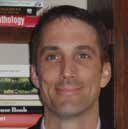Article
2013 Technology Innovator of the Year Finalists

Technology Innovator of the Year
Sponsored by:


Eric Beyer believes that technology should be used to give pharmacists more time to spend educating their patients.
Beyer earned the position of chief of pharmacy and clinical director at Chippewa Cree Medical Center in Box Elder, Montana, within his first year of graduating from the University of Montana, School of Pharmacy. At the same time, he also served as a pharmacy consultant for PharMerica. After gaining valuable professional experience, he opened his first retail pharmacy in Frenchtown, Montana.
He was then contacted by the Granite County Medical District, and he agreed to accept the position of pharmacist in charge for the hospital in Phillipsburg. Recognizing a community need, he became the first pharmacist in Montana to set up and manage a telepharmacy that served residents of rural communities—residents who otherwise might not have had access to affordable pharmaceuticals and pharmacists.
Working closely with the Montana State Board of Pharmacy and several technology companies, he developed a safe and efficient model for providing patient care to these rural residents. He contracted with Global Med to build software similar to Skype, allowing employees to communicate between pharmacies hundreds of miles apart with security features that meet HIPPA regulations. This technology is also used to counsel patients at telepharmacy locations.
Beyer’s advances in technology also include IOS applications created by PioneerRx that streamline pharmacy tasks, including a counseling app that allows real-time access to patient information, drug-to-drug interactions, and Pharmex warnings. An app for delivery drivers guides staff with GPS navigation and allows them to scan Rx and retail items, store signatures, and accept any form of payment. His patients also have the option of signing for their prescriptions on an iPad and viewing prescription information or ordering refills for anyone in their household right from their smartphones.
Beyer ensures that his pharmacy’s website is up-to-date with the latest news and pharmacy information and hopes to offer medical and health training for professionals through his website in the future.
Following the success of his telepharmacy, Beyer once again addressed the needs of his community, opening his third pharmacy, which works with the Community Health Center of Libby, Montana, to provide 340B services to patients. The pharmacy uses the latest technology, giving him and his staff members more time to interact with their patients.

Blending his knowledge of pharmacy and business, Michael Einodshofer uses technology to reduce payer and patient costs while improving the quality of care.
Einodshofer earned his bachelor’s degree in science pharmacy and his master’s in business administration from the University of Pittsburgh, where he also learned how to write computer software. Using these skills as a pharmacist at the Washington Hospital in Pennsylvania, he created a business plan that expanded the hospital’s outpatient pharmacy and led to a 300% increase in revenue within 2 years.
As director of pharmacy operations at University of Pittsburgh Medical Center Health Plan Insurance Services Division, Einodshofer managed teams responsible for pharmacy benefit manager relations, specialty pharmacy programs, pharmacy configuration, call center operations, prior authorization operations, and regulatory compliance. He developed and maintained the pharmacy formulary database and created fraud, waste, and abuse algorithms that systematically analyzed medical and pharmacy claims, identifying more than $3.5 million in overpayments over a 2-year span.
Einodshofer continues to develop new programs in his current position as the director of utilization management at Walgreens Specialty Pharmacy in Pennsylvania. Most recently, he developed the Walgreens one-of-a-kind Medical Benefits Management program to address unmet needs of employer groups and health plans, cutting the cost of specialty therapies by approximately half, which can save clients an estimated $9000 to $300,000 per patient per year.
With the help from his team, Einodshofer takes raw claims data submitted by 31 clients and builds queries to extract information that identifies patients whose specialty drug costs can be lowered through site-of-care optimization for infusion therapies and other initiatives, including physician office specialty drug distribution and clinical and formulary management.
In recognition of his work, Einodshofer has received the University of Pittsburgh Medical Center Health System ACES Award for Commitment and Excellence in Service and Six Sigma Green Belt Certification. He is an adjunct instructor in pharmaceutical sciences at the University of Pittsburgh School of Pharmacy and is a member of the peer review panel of American Health & Drug Benefits. He has presented at several professional meetings including the National Association of Specialty Pharmacy, the Conference Board Annual Employee Health Care Conference, and the Pharmacy Benefit Management Institute Annual Conference.

With more than 19 years of experience in the United States Navy, Dr. Marc Young has focused his career on implementing new technology to improve project management.
Dr. Young graduated with his doctorate in pharmacy from Idaho State University and began his career as a clinical pharmacist in Arizona. A few years later, he studied pharmacy care systems at Auburn University, earning a master’s degree and leading him to become the program manager of the Defense Medical Standardization Board at Fort Detrick in Maryland. In this position, he was responsible for establishing and executing testing for the $3.2 billion stockpile of emergency response pharmaceuticals maintained at locations worldwide. Dr. Young implemented the first Web-based reporting tool for more than 900 users of the single data source for the stockpile, establishing multiple system-to-system interfaces with other government systems.
During this time, Dr. Young also worked to establish a series of “firsts” in Navy medicine. He launched and supervised Envision Telepharmacy, the first outpatient telepharmacy program, initiated the first shelf life extension program electronic data interchange, eliminating hours of manual data mining, and implemented the first set of governance policies and priorities for the Navy pharmacy community.
In his current position as the director of project management for the Medicine Information Systems Support Activity in Texas, Dr. Young supervises a team of 35 project managers for more than 70 direct care clinical information systems and business systems used in Navy medicine globally, including electronic health records and pharmacy systems, with an annual budget of $65 million. He has developed requirements and acquisition strategy for the Joint Drug Information Resource, providing integrated Clinical Decision Support in the MHS Electronic Health Records.
Dr. Young has also been instrumental in developing mobile applications. He received approval and funding for a joint Department of Defense and Department of Veterans Affairs application development environment that provides both agencies with a common development framework and shared tools to develop apps. He also developed the Electronic Pharmacy Mobile Application, which allows beneficiaries to fill new prescriptions, refill existing prescriptions, and access their prescription history from their smartphones. He was recognized by the American Society of Health-System Pharmacists as an honored Member for Practice Excellence and Leadership for his work on the app.






